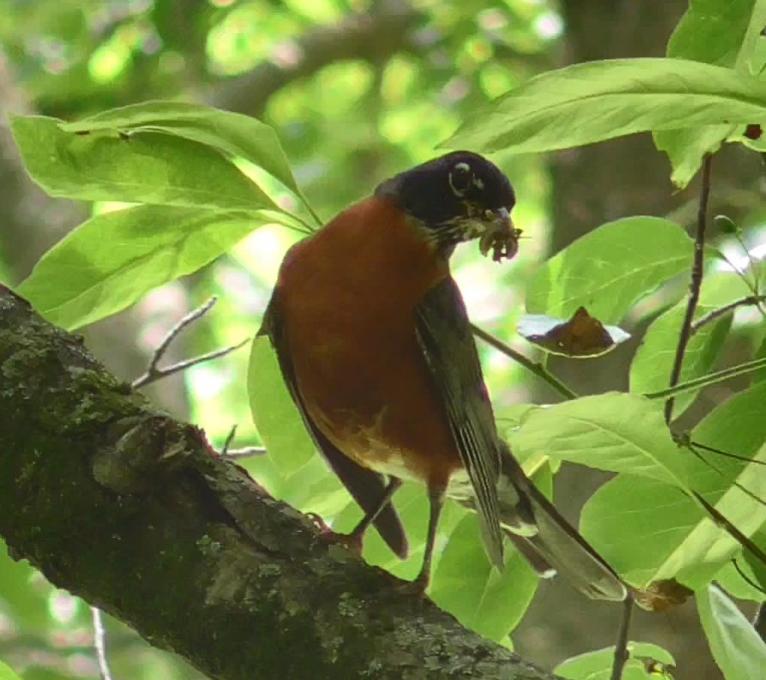The Cornell Lab Bird Academy › Discussion Groups › Joy of Birdwatching › Activities: Bird ID Practice
-
A1: Canada Goose and Trumpeter Swan. The swans have much longer necks. Both waterfowl are found in a pond nearby my house. A2: Lazuli Bunting, Indigo Bunting and Varied Bunting. Each of these birds are blue. The Lazuli Bunting has a light brown - orange breast whereas the Indigo Bunting has brown wing patches. Varied Buntings have red and purple hues. A3: Canada Geese were eating grass, a Ring-Billed Gull was scavenging garbage and an American Robin bobbed for worms. A4: My favourite bird is smaller than an American Robin. They have bright green backs and wings, purple chests, bright yellow bellies and light blue tails. Their heads can be black, red or yellow. Their beaks are off-white. They are native to northern Australia. They are chatterers with a persistent chirp. My favourite bird is... Gouldian Finch.
-
For activity number one the two birds I identified by shape were the blue jay and the chimney swift. Even though I was familiar with these birds and able to identify them easily by shape I did try and enter them on Merlin to use it for identification. For both birds it told me there were no matches. I moved on to activity number two. For this activity I decided to focus on birds with the color red. For my first bird I chose a red-winged blackbird. I put it in Merlin and it came right up. Then I put in a Northern cardinal, and again it came right up. For my third bird I tried a downy woodpecker. When I put it in Merlin it told me there were no matches. I tried changing some of my choices like the size and then rather than viewed at my feeder, up in the tree it was in previously. Still no matches. Then I decided I would try a ruby-throated hummingbird. Onces again it gave me no matches. I then gave up on Merlin and closed it. Then after a little time had gone by I decided to try again. I opened it up and put in the statistics for the downy woodpecker and it came right up as the first choice. Then I went back to activity number one and put in both the blue jay and the chimney swift. Both came right up as the first option. For activity number three, I observed the red-winged blackbird sitting on a lotus flower at a nearby pond. He went from flower bud to flower bud picking them apart and eating parts of them. I also observed an Eastern kingbird also sitting on the lotus flowers where it perched and hunted for bugs. It would zoom out and grab a bug and then return to the same lotus flower it had been perched on. Then came the most exciting bird I observed feeding. I watched an osprey circle the pond up in the air and then suddenly it tucked it's wings and slammed down into the water causing a large splash, and then coming out of the water with a fish in it's talons. It flew off with the fish and unfortunately flew out of view. One of my favorite birds is the Eastern Bluebird. These small, often plump appearing little birds have rounded heads and bodies and are between the size of a sparrow and a robin. The males are a brilliant blue with a rusty reddish-orange breast and a white underside. The females are like a muted version of the males with a brown head, back, and wings with a muted blue cast and washed out rusty reddish-orange breast and a white underside. These birds perch on telephone wires, fences, and branches in areas where they can look out over open fields where they hunt for their favorite foods, insects. You will often see them fly to the ground and grab a bug and then go to the same or another perch to eat their catch. They are cavity nesters that readily take nest boxes. The male feeds the female while she sits on the nest and both parents take part in rearing the chicks. When not tending to nest or young, Eastern bluebirds can often be found hanging out in small groups.
-
Activity 4: My favourite is the Northern Cardinal. I notice the male more often than female, males are mostly red with a black face especially around the bill and their size is between sparrow and robin. I usually find them briefly at the bird feeders or on the lower branches of trees.
-
Activity 3 Great blue heron wading and eating fish, Turkey vulture eating carrion, American goldfinch eating flower seeds.
-
Activity 4: Hi everyone, my name is Jamies. I have been traveling back and forth from Edmonton and Calgary. I have spotted many birds. My favorite bird is the American White Pelican. This bird has a body white in color, bigger than a Canada goose, has a big long yellow beak and eye ring. I would have uploaded a photo of it if I have a powerful camera with great zooming function. I only use my smartphone to take bird photos right now. Activity 1: The two birds I can distinguish by their shapes are red-winged blackbird and ring-billed gulls. The blackbird is smaller in size, and a male is black with a red shoulder patch. The beak is triangular shaped and pointed. The ring billed gull is smaller than a goose, but larger than a crow. It has a black ring around the beak. It also has white chest and belly. Also, this gull has a yellow beak.
-
Trying out these activities at my bird feeder 1. Steller's jay (large small bird, crest on head) vs black capped chickadee (tiny, spherical) 2. 3 birds in portland that are back American Crow - all black Red winged black bird - mostly black w red shoulders (male) Brown headed cowbird - black mostly but brown head 3. Food strat at feeder - spotted towhee, black headed junco - picks at food on ground - black capped chickadee, downy woodpecker- eat from hanging feeder
-
 Activity 4: The Malachite Sunbird is a slim bodied, nectarivorous bird, although will eat insects, especially when feeding their young. This is a photo taken from my nectar bottle bird feeder, such an electric colourful striking bird, it is a beauty, one of my favourites. The Malachite sunbird has a long down-curved bill, enabling it to nectar feed from flowers or feeders. It seems that this bird's plumage is all one colour, metalic green, but it does have blackish green wings and its belly is an electric teal blue, this bird has a very slender long tail up to 25cm long. This sunbird is found in hilly fynbos areas, feeding off aloes and proteas. It is found in parks and gardens as well. The call is quite distinctive and often I hear the call before I see the bird, and then I start looking up to see where it is, it is a shrill tseep-tseep sound. The chicks are fed by both parents until fledging time, and the chicks will up to a certain time return to the nest to roost.
Activity 4: The Malachite Sunbird is a slim bodied, nectarivorous bird, although will eat insects, especially when feeding their young. This is a photo taken from my nectar bottle bird feeder, such an electric colourful striking bird, it is a beauty, one of my favourites. The Malachite sunbird has a long down-curved bill, enabling it to nectar feed from flowers or feeders. It seems that this bird's plumage is all one colour, metalic green, but it does have blackish green wings and its belly is an electric teal blue, this bird has a very slender long tail up to 25cm long. This sunbird is found in hilly fynbos areas, feeding off aloes and proteas. It is found in parks and gardens as well. The call is quite distinctive and often I hear the call before I see the bird, and then I start looking up to see where it is, it is a shrill tseep-tseep sound. The chicks are fed by both parents until fledging time, and the chicks will up to a certain time return to the nest to roost. -
A beautiful female cardinal had similar colors to the male. I found these near my friend's bird feeder. The hood of the female was the biggest difference as well as some of the color schemes. That helped me notice the difference between the male and female.
-
Activity 3, using three birds I observed yesterday (July 21, 2020) here on Nantucket:
- Cedar Waxwing: It perched on top of a leafless tree next to a tall bush full of red berries. It would fly back and forth from the berry bush to the perch, grabbing a berry from the bush before taking it to the perch to gobble it down.
- Snowy Egret: It stood in shallow water at low tide near where the bay transitions to a salt marsh, actively running back and forth through the shallows and aggressively poking its beak into the water to spear fish.
- Downy Woodpecker: It scurried up and down a tree and drummed on the bark, looking for insects to munch on.
-
Activity 1: Australian Raven and Pied Currawong are similar in size and colouring. The major difference in shape is that the Raven has a shaggy bunch of feathers at the front of its throat. Activity 2: Australian Magpie, Magpie Lark and Pied Currawong are all black and white birds. The Magpie has white on its nape, shoulder, and rump, with a band on its wing. The Magpie Lark has a white belly and a white stripe down the side of its head as well as a band on its wing. The Pied Currawong just has a white stripe on its wings and white underneath its tail. Activity 3: On my walk tis morning I saw a Little Black Cormorant diving for food in a small lake, an Australian Magpie sitting on the ground sing its beak to explore its surroundings looking for food, and a Red Wattlebird in a shrub looking for nectar. Activity 4: One of my favourites, and a regular visitor to my garden is the Galah. They are parrots, larger than a crow, but smaller than a goose. The have grey wing and back, with a pink body, neck and face. They also have a crest, which is a paler shade of pink. They are common throughout Australia, all year round. Their voice is a very harsh screech (although not as harsh as the Sulphur Crested Cockatoo!)
-
I went with American Goldfinch.
- They're tiny little songbirds.
- The male has a bunch of black-white zebra stripes on his wings.
- The male also has a cheery little black cap on his head.
- And, oddly enough, they like to be at the veeeeery top of tall trees, or at least on a jutting-out branch.
-
This is exercise 4. One of my favorite birds is spotted towhee, the one of the first I learned to identify . Its size is between a sparrow and a robin. It has rust colored flank, white belly, black head/hood, black wings with white spots, and devilish looking red eyes. It likes to forage in the low shrub and on the ground, but will perch at a higher branch to sing. I don't know how to describe its sound other than to say that it is a very loud and distinctive trill. It uses both feet to scratch away leaves or dirt to find its food. So in an area with lots of dried leaves and other debris son the ground, between its song and its foraging technique, it's easy to "hear" and ID it even without being able to spot it right away.

-

 A spotted towhee in my yard. We’ve never had this kind of bird before.
A spotted towhee in my yard. We’ve never had this kind of bird before.
-
I downloaded Merlin and used it to identify a barred owl and a gray catbird. The catbird was trickier because I was trying to identify it by size and color, and it didn't even come up as an option. I finally had to snap a photo of it, which quickly helped me identify it. I've never heard of a gray catbird before, so I was happy to learn something new.
-
ACTIVITY 2: The past July 14, 2020, I went to a natural reserve in Ponce, Puerto Rico because the previous day a man reports a Gull-billed Tern on eBird (rare in PR and a potential LIFER for me). Upon my arrival, I began to search for my Gull-billed Tern. Among a lot of birds, I was able to quickly identify Least Terns, Roseate Terns, Royal Terns, Sandwich Terns, Wilson's Plover, Ruddy Turnstone, Black-necked Stilt, White-cheeked Pintal, and other. Two terns caught my attention as they seemed to be the Gull-billed Tern. I took photos to ID the bird but, to my surprise, these two birds proved to be juveniles of Roseate Tern and Sandwich Tern. So, I lost my possibility to get a LIFER. No Gull-billed Tern for me for now.


-
Activity 1: I went out for a walk and saw some birds with forked tails. I was able to find them in Merlin as barn swallows. ( I had never noticed them before) I also went to the park today and saw a larger bird flying above with reddish tail feathers and identified it as a red tail hawk. I had never paid much attention to the shape of birds tails, body shape, and size before, so it has been good to be more observant of these things. There were many different birds at the park, but too far away or too fast to get a good photo to put into Merlin. I took a photo of a large black bird on the top of a tall tree. I thought it was probably a crow, but wanted to see what Merlin said- it said it was a wood duck, which I thought was funny, as there was no water around the park.
-
My favorite bird is the American Goldfinch. It is a bright yellow bird with black and white marking on its wings, white coloring on the underside of its wing, a black patch on its forehead that comes down to the top of its beak and extends up to the crown of its head. The black patch also extends horizontally to the eyes and the top of the cheeks. It is a small bird with a cheerful chipping sort of sound and it loves thistle and coneflower seeds and really seeds of all kinds. It will perch on various flowers it is so light. It's feet are a pale orange and it's beak is a slightly brighter orange. Its tail is a medium length, about half the length of its body, and the beak is short, pointed, but with a wider base- a typical finch beak. The female is less brightly colored, but is still a softer yellow, a sort of wash of color. There is a light brown coloring mixed with the pale yellow, and the female doesn't have a black head marking, and there is less black in the wing. According to Audubon, the goldfinch will also drink maple sap and eats some insects, but mostly seeds.
-
barn owl medium buff wings and back with white front black,gray speckles, night carnivore
-
A bird I really like- we had a Junco fly into our kitchen yesterday through an open window. He actually let my husband gently catch him to set him free outside. Small bird with a long tail. His beak is small and pointy. Dark grey color with a white belly. We are on a small island in Maine with forest and meadow habitat. I believe this bird is a seed eater. Beautiful. A Dark Eyed Junco.
-
I also heard an Alder Flycatcher... Cool!
-
 Activity 1- This Ring Necked Pheasant was in my yard this morning. Also observed a flying medium sized bird with a longish tail and dark color. It was either a brown headed cowbird or a starling.
Activity 1- This Ring Necked Pheasant was in my yard this morning. Also observed a flying medium sized bird with a longish tail and dark color. It was either a brown headed cowbird or a starling. -
Activity 3 (Observe birds searching for food) House finches: Visiting the hanging feeders, usually in groups of two to five at a time. They are always up on the feeder, never on the ground. They usually want the seed and fruit mix, sometimes thistle, not suet cakes. Chipping sparrows: Usually on the ground, they did visit the feeder a time or two for the seed and fruit mix. On the ground they forage under the feeder and also on the paved driveway and in shallow grass and weeds. They seem to be eating both seeds and insects. Ruby-throated Hummingbirds: The hummers were at the feeders drinking sugar syrup and at the hostas and cardinal flowers, but I saw something else today that surprised me. In an azalea bush near to where I was sitting was a spider web. A hummingbird approached the web and picked three little insects out of the web! Poor spider did all the work, only to have her dinner snatched from her plate! American Robin: The robins were foraging on the ground in a shady lawn area. I saw one take something wriggly (a grub, maybe?) from the ground and then perch on a tree branch to eat it.

-
I’ve been using the Merlin app for about four months and it’s what ultimately lead me to this course. I’ve found the app quite helpful and fun to explore the birds, even to help learn the different songs. Great course so far!
-
Activity 2: interesting to identify house wren and Carolina wren. I can tell them apart if the lighting is good, but it's difficult in poor lighting. Read the description of both birds on Merlin - it says the tail of Carolina wren is as long as the body, while the tail of house wren is shorter. Nice tool for ID'ing!
-
Activity #2- red-winged blackbird, robin, downy woodpecker, all have red markings on different parts of their body. The red-winged blackbird has a red band on its wing, the robin a red chest, and the downy woodpecker has a red cap. Activity #3- birds looking for food. Not all of these were today. In the spring after the wrens hatch there is always a time when I am keeping an eye out for crows, as they steal and eat the young. This year, a pair of robins nested in the euonymous along my back fence, and the male was continually chasing out predators, and I am afraid the crows may have gotten their first clutch at least. I never saw any fledglings. And one crow captured a baby rabbit and flew away with it. The crows are very devious, and once they know where a nest is, or for that matter a group of baby rabbits, they will be back for another meal. Last fall there were various kinds of woodpeckers all over the yard looking for insects. They even tried to get insects out of old garden stakes that were still up. Lately there have been many goldfinches lighting on the Black-eyed Susans in my rain garden looking for seeds, and an unknown brown bird has been foraging for insects or seeds in the ground. I thought that I saw one of them fly away with a big worm in its mouth this morning, but was not sure. Previously I had thought that they were seed gatherers. I haven't been able to I.D. this bird. It is not new to the area- I have had them follow me around as I weed in the garden or even follow me around as I use the trimmer to trim the weeds. I think that they may be juveniles, as they are very drab in their coloring, and I cannot find them in any book. I have a Rufus hummingbird that I see almost daily feeding on various flowers around the garden- Another yearly occurrence is something I refer to as a sort of sparrow party. When the seeds from the goatsbeard are ripe, the sparrows form a group around the plants and hop upwards to grab at the seedheads. They also will do this with millet. It is quite a lovely sight to see- And of course, after I water the vegetables in the morning, the robins come out to look for worms. I may take a hike and redo this activity in an outdoor space less familiar to me. I will likely have a very different set of birds.
Read More:
 Activity 4: The Malachite Sunbird is a slim bodied, nectarivorous bird, although will eat insects, especially when feeding their young. This is a photo taken from my nectar bottle bird feeder, such an electric colourful striking bird, it is a beauty, one of my favourites. The Malachite sunbird has a long down-curved bill, enabling it to nectar feed from flowers or feeders. It seems that this bird's plumage is all one colour, metalic green, but it does have blackish green wings and its belly is an electric teal blue, this bird has a very slender long tail up to 25cm long. This sunbird is found in hilly fynbos areas, feeding off aloes and proteas. It is found in parks and gardens as well. The call is quite distinctive and often I hear the call before I see the bird, and then I start looking up to see where it is, it is a shrill tseep-tseep sound. The chicks are fed by both parents until fledging time, and the chicks will up to a certain time return to the nest to roost.
Activity 4: The Malachite Sunbird is a slim bodied, nectarivorous bird, although will eat insects, especially when feeding their young. This is a photo taken from my nectar bottle bird feeder, such an electric colourful striking bird, it is a beauty, one of my favourites. The Malachite sunbird has a long down-curved bill, enabling it to nectar feed from flowers or feeders. It seems that this bird's plumage is all one colour, metalic green, but it does have blackish green wings and its belly is an electric teal blue, this bird has a very slender long tail up to 25cm long. This sunbird is found in hilly fynbos areas, feeding off aloes and proteas. It is found in parks and gardens as well. The call is quite distinctive and often I hear the call before I see the bird, and then I start looking up to see where it is, it is a shrill tseep-tseep sound. The chicks are fed by both parents until fledging time, and the chicks will up to a certain time return to the nest to roost. 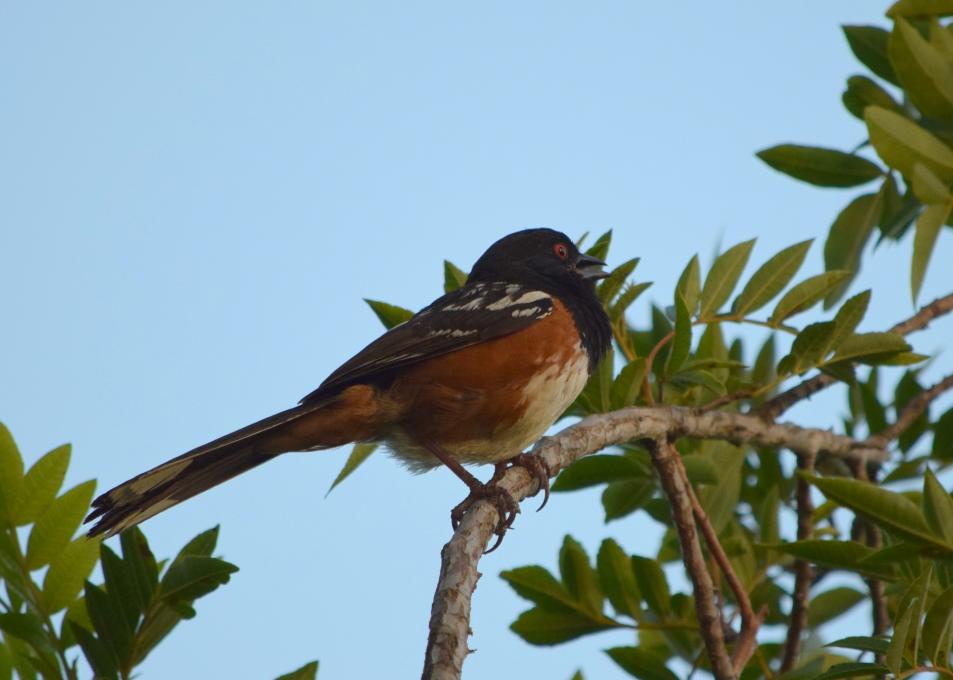
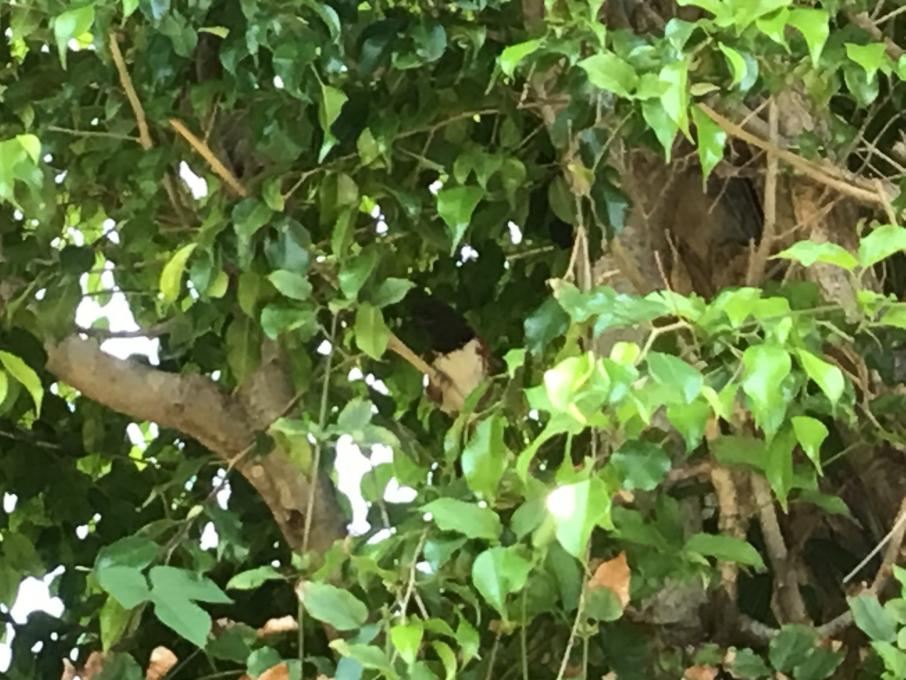
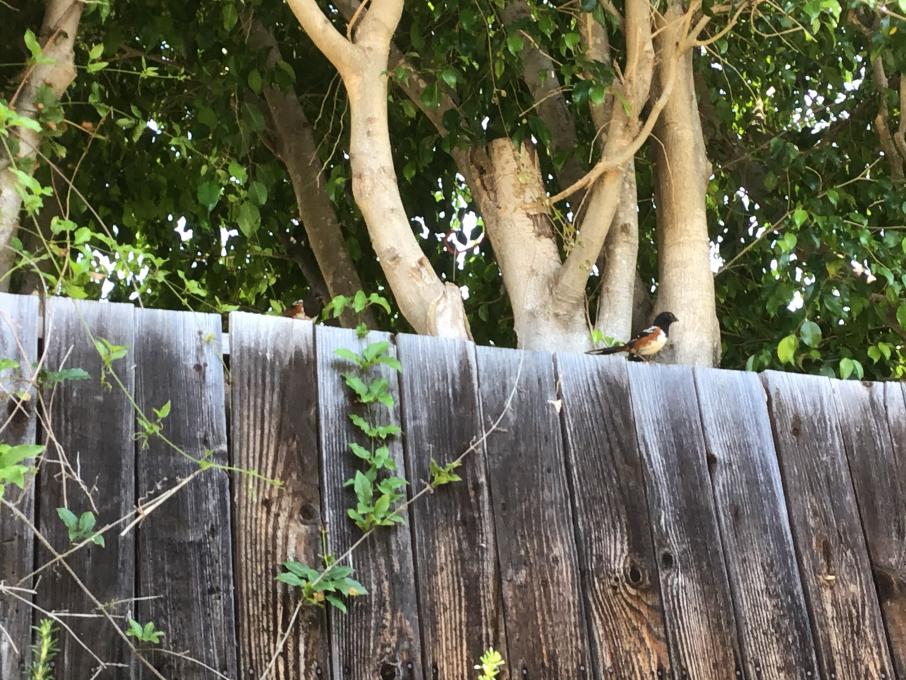 A spotted towhee in my yard. We’ve never had this kind of bird before.
A spotted towhee in my yard. We’ve never had this kind of bird before.
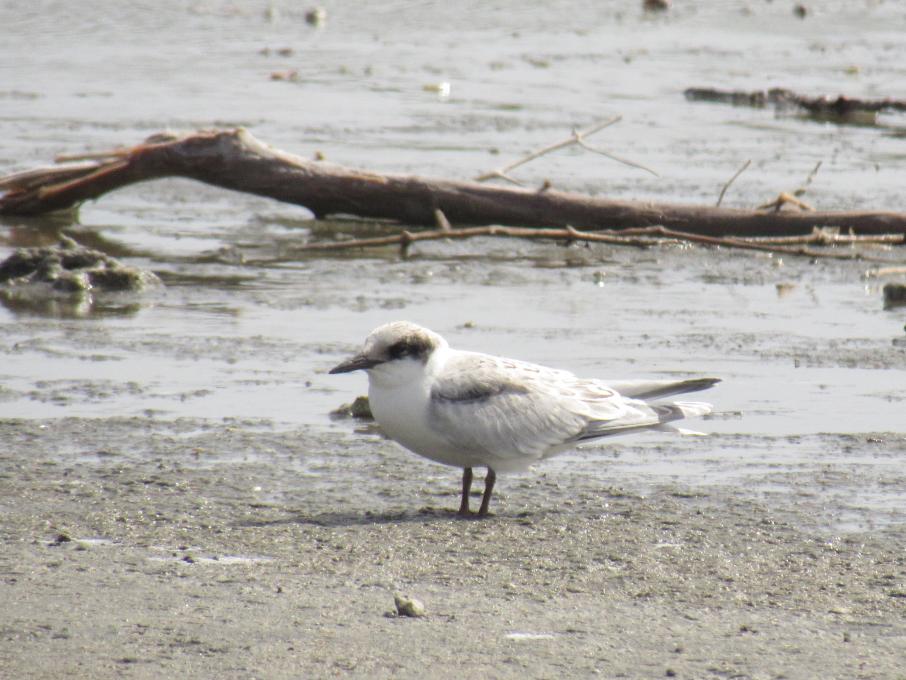
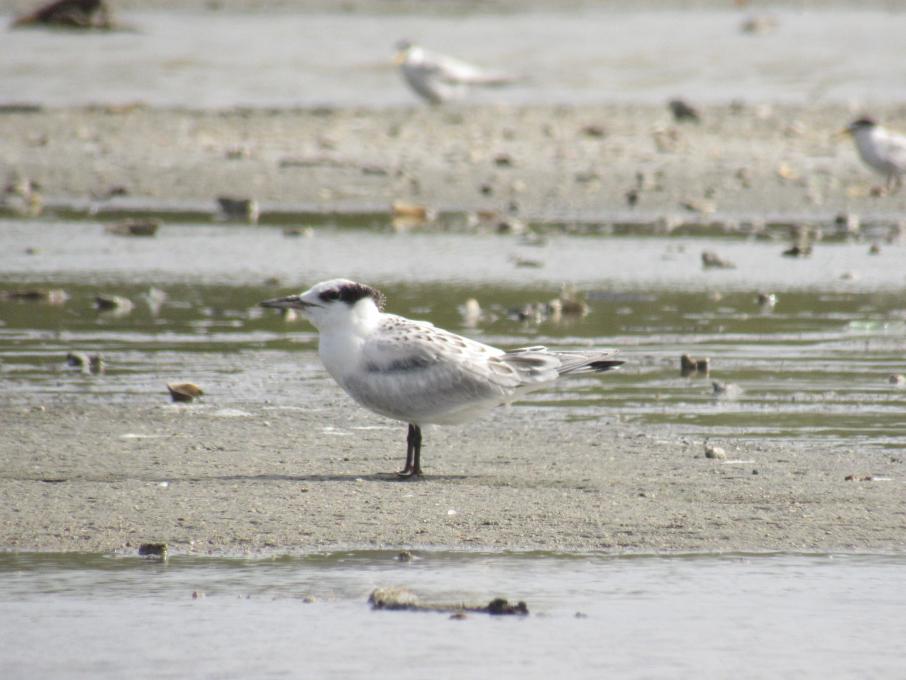
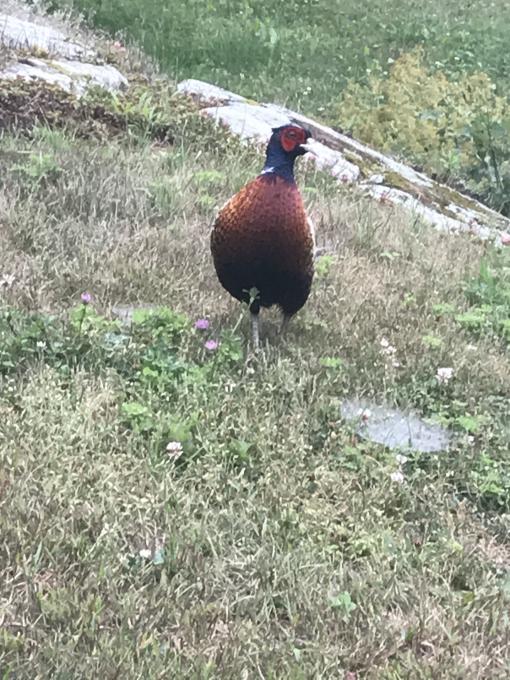 Activity 1- This Ring Necked Pheasant was in my yard this morning. Also observed a flying medium sized bird with a longish tail and dark color. It was either a brown headed cowbird or a starling.
Activity 1- This Ring Necked Pheasant was in my yard this morning. Also observed a flying medium sized bird with a longish tail and dark color. It was either a brown headed cowbird or a starling. 